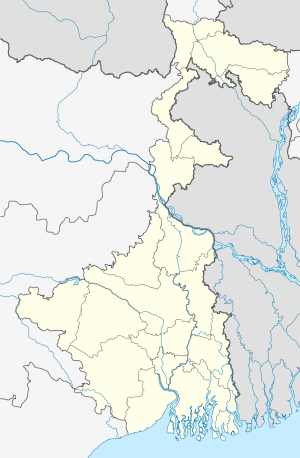Pandua, Malda
| পান্ডুয়া | |
 Shown within West Bengal | |
| Alternate name | Hazrat Pandua, Firuzabad |
|---|---|
| Location | West Bengal, India |
| Coordinates | 24°52′N 88°08′E / 24.867°N 88.133°ECoordinates: 24°52′N 88°08′E / 24.867°N 88.133°E |
| Type | Settlement |
| History | |
| Founded | 14th century |
| Abandoned | 15th century |
Pandua is a ruined city in the Malda district of the Indian state of West Bengal. Pandua is now almost synonymously known as Adina, a small town located about 18 km North of Malda Town.
History
The city was probably founded by Sams-ud-Din Firuz Shah.[1] In 1339, Ala-ud-Din Ali Shah transferred his capital from the nearby (and now ruined) town of Lakhnauti or Gaur (32 km from Pandua) to Pandua.[2] Later, Haji Shamsuddin Iliyas Shah, the first independent Sultan of Bengal, made the city the capital of his (unified) Bengal Sultanate. However, Pandua's glory was short-lived. In 1453, the capital was transferred back to Gaur by Nasir-ud-Din Mahmud Shah, perhaps necessitated by a change in the course of the river on which Pandua stood.[3]
Geography
Pandua is located at 25°08′N 88°10′E / 25.13°N 88.16°E.[4]
Monuments
The monuments of Pandua were built in the Bengal provincial style of the Indo-Islamic architecture. Pandua's most celebrated monument is the Jami Mosque or the Adina Mosque, which was described by James Fergusson as the finest example of Pathan architecture in existence, though some believe it to be a conversion of a temple. This great mosque (similar in plan to the great mosque at Damascus) was built by Sikandar Shah in 1369. Other important monuments of this city are the Eklakhi mausoleum (the mausoleum of Jala-ud-Din Muhammad Shah) and the Qutb Shahi Mosque (built in the memory of Sufi saint Nur Qutb-ul-Alam). The Eklakhi mausoleum is a single-domed square type of structure, whose fabric is of brick, occasionally interspersed with hornblende slabs collected from older Hindu monuments.[5] Pandua is now (like Gaur) almost entirely given over to the wilderness.
See also
Notes
- ↑ Majumdar, R.C. (ed.)(2006). The Delhi Sultanate, Mumbai: Bharatiya Vidya Bhavan, p.193
- ↑ Mahajan, V.D. (1991, reprint 2007). History of Medieval India, Part I, New Delhi: S. Chand, ISBN 81-219-0364-5, p.274
- ↑ Majumdar, R.C. (ed.)(2006). The Delhi Sultanate, Mumbai: Bharatiya Vidya Bhavan, p.212
- ↑ "Yahoo maps location of Pandua". Yahoo maps. Retrieved 2008-12-21.
- ↑ Majumdar, R.C. (ed.)(2006). The Delhi Sultanate, Mumbai: Bharatiya Vidya Bhavan, p.690
References
-
 This article incorporates text from a publication now in the public domain: Chisholm, Hugh, ed. (1911). "article name needed". Encyclopædia Britannica (11th ed.). Cambridge University Press.
This article incorporates text from a publication now in the public domain: Chisholm, Hugh, ed. (1911). "article name needed". Encyclopædia Britannica (11th ed.). Cambridge University Press.
External links
-
 Gour-Pandua travel guide from Wikivoyage
Gour-Pandua travel guide from Wikivoyage -
 Gaud travel guide from Wikivoyage
Gaud travel guide from Wikivoyage - Pandua in archnet.org
- Adina Mosque in archnet.org